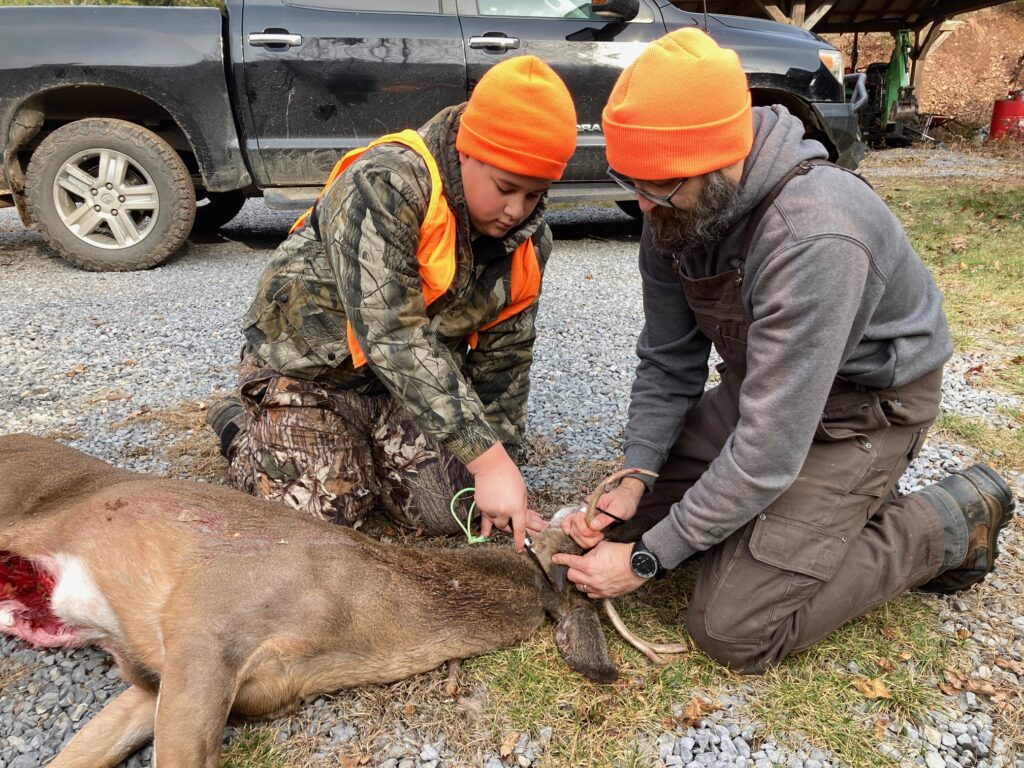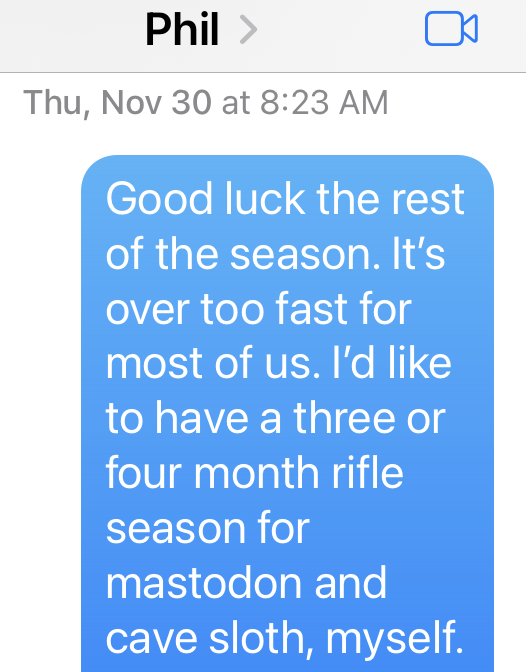Posts Tagged → conservation
Some wonderful people gone
Jokes abound about aging, and quite a few are about those friends and family members who do not age with us, but who leave us all as we continue our own trajectory. Well, I am now definitely in the “aging” category and I am increasingly surrounded by people I enjoy and love who suddenly depart from this life. Recently two people here in Pennsylvania have left us all, and moved on to the spirit world, who I would like to mention. And it’s no joke, this dying thing. No matter what age a person is when they depart this life for the next, there is nothing funny about it.
Except maybe the last day on earth of European-Mexican artist Frida Kahlo, whose wild and often debauched Marxist Bohemian lifestyle made for intriguing movies and books. While some or maybe even a lot of the facts of Frida’s life may be funny depending upon the person considering them, her actual physical departure from this planet really is funny. I think.
After Frida died relatively young from cancer, or whatever it is that eventually afflicts the heavily debauched, her friends had her corpse dressed beautifully in her most customary colorful and flamboyant way, and prepared themselves all for a formal cremation send-off party in whatever crematory was present in Mexico City at the time. Her friends gathered in the crematory room while Frida’s corpse was ceremoniously loaded into the burn chamber, and as the roaring natural gas flames came to life, they all raised their glasses and toasted Frida.
And then the room erupted in gasps, cries, and people running for the exits, because suddenly Frida’s corpse stiffly bent at the waist, sat up, and made a wicked grin as her abundant hair caught on fire and created a demonic flaming halo around her yet untouched face. She wasn’t actually gone!
Yes, this was all her body’s muscular reaction to the sudden burst of 2,000-degree heat enveloping it, but apparently if you knew Frida, you kind of didn’t expect her to just die, you know, lie still and never move again. And indeed, she had lived up to all the hype about her, even while lying quite dead in the cremation chamber. I think this true story is funny, even though I did not know Frida and was not present at her cremation.
What is not funny and yet is not unexpected is the recent departure of Jim Brett, of Lenhartsville, PA, which for our geographically challenged readers is just north of I-78 and just south of Blue Mountain in Berks County, PA. Still confused where Lenhartsville, PA, is? OK, yes, it is the equivalent of East Succotash, PA, Nowheresville, PA, etc., and it is just about next to Hawk Mountain, the internationally famous sanctuary devoted to conserving birds of prey, especially on their annual migration south. There, solved this location question for you.
Hawk Mountain started as a simple land purchase to keep the shotgunners from standing on Blue Mountain’s highest Tuscarora sandstone boulder ridgetop and mindlessly swatting down out of the sky nearly every raptor that flew by on its way to South America. And in short order, more land purchases were added to what is now called the Kittatinny Ridge migration corridor. Hawk Mountain eventually became an educational organization and a destination for birders.
In the 1930s, birds of prey (hawks, owls, eagles, kites, vultures) were considered pestilential nuisances to farmers’ chickens and the rabbits and pheasants hunters enjoyed pursuing. In time, around the 1930s, raptors gradually became understood by some Americans as an important part of a healthy and properly functioning ecosystem, just as balanced populations of wolves, bears, mountain lions, bobcats and fishers have been subsequently understood today.
Hawk Mountain is now the world’s oldest continuously functioning conservation organization, but from 1934 to 1966 it was kind of a hidden gem, a hole in the wall of Blue Mountain that only certain initiates knew about or appreciated. It became much better known and more widely appreciated and much visited after Jim Brett became its second “curator,” as the chief executive position there is uniquely called.
As its leader, Jim Brett elevated Hawk Mountain to international status, built lots of buildings, hired lots of staff, attracted a lot of visitors, raised a lot of money, and he became a leading voice in bird conservation around our little blue and green planet.
On the outside, Jim Brett was a colorful Irishman, full of naughty jokes and a singular ability to imbibe liberally (often of his own make) and then hold forth to a captivated audience about biological and ecological science. But because Jim’s mother was Jewish, he had a separate interest in Israel, which, because it sits on a physical crossroads, is a lot like Blue Mountain. Israel is a birding Mecca.
A “sh*t ton” as Jim would say of raptors, storks, and other incredible and rare bird populations migrate through Israel, and Jim made their conservation from one end of their migration to the other one of his life’s missions. His Jewish half worked well with the Israelis, and his Irish half worked very well with the surrounding populations. One of his crowning achievements was working with Yossi Leshem to resolve bird strikes on Israeli fighter jets.
By finding ways to greatly reduce large rare birds being suddenly introduced to fighter jets at 1,000 mph, Yossi Leshem & Co. were able to save the lives of said rare birds, said giant titanium war eagles, and unsaid but implied young fighter pilots. It really was one of the great wild birds-living-with-modern-humans conservation success stories.
I met Jim Brett in 1998, when I had started working at PA DCNR in Harrisburg (having fled the corrupt and destructive US EPA in Washington DC). He was giving a presentation at an environmental and conservation education conference in Harrisburg, PA, and as the DCNR director of said polysyllabic educational field, it was my duty to both speak and to listen. Jim was standing up on the stage showing ancient stone tool artifacts and explaining the nexus between primitive hunter-gatherer lifestyles and the conservation or decimation of wildlife. I was hooked immediately.
Jim and I maintained a close personal and professional relationship until Fall, 2009, when I ran in a congressional primary (I was prompted to run by the devoutly corrupt and evil Manchurian Candidate Barack Hussein Obama, then president for nine months). My expressing my long quietly held political views educated not just Jim, but a sh*t ton of my “friends” and fellow conservationists alike about my true self. Gasp. Turned out that Jim did not know how conservative I was, and I did not know how liberal Jim was, and despite my desire to remain close, Jim had a hard time with it.
After 2009, our relationship involved less and less personal time, and fewer phone calls. I still have a generous gift that Jim gave me, which I occasionally take out and look at, admire, and then put it back in its safe place.
Jim and I stayed in touch through mutual friends for many years, including those who went on his African safaris he led. I can still recall Jim describing the funeral rite for a young son of a Maasai tribal leader, which he witnessed some time in the 1980s, I think: The boy’s body was ritually washed and then slathered in lamb fat, then put in the chieftain’s hut. The entire village was then evacuated and moved to an entirely new location, where a new settlement would be constructed. After the hyenas had entered the old village and consumed the boy’s body, the entire place was torched and left to become natural ecosystem thereafter.
Jim’s bright blue eyes flashed as he told this story, as indeed one would expect from someone so in tune with the endless hidden vibrations of our magical natural world. Though I know his spirit is now soaring with the majestic raptors, I doubt Jim’s liver will ever go the way of the hyena, Frida, or any mortal flesh for that matter. His official obituaries are here and here.
A second loss is someone I knew less closely, but with whom I shared a great deal in common and with whom I filled my buck tag this season: Phil Benner of Liberty, PA.
Until he unexpectedly died of Covid several days ago, the incredibly physically fit Phil Benner was a devoted father, a devoted husband, a devoted brother, a devoted uncle, a devoted son. He was a hard working small business owner, a risk-taking entrepreneur, and a pastor who saw God and felt Him deeply in the natural world around him, including the leaves rustling in the winter tree branches, and the quiet tinklebell sound of a small mountain stream’s clear waters falling over boulders. He appreciated everything and took nothing for granted.
Not only will I miss Phil Benner, the world will miss Phil Benner, because the world needs a billion more gentle, charitable, loving, devoted, kind, tolerant, peaceful Phil Benners. His loss is huge.
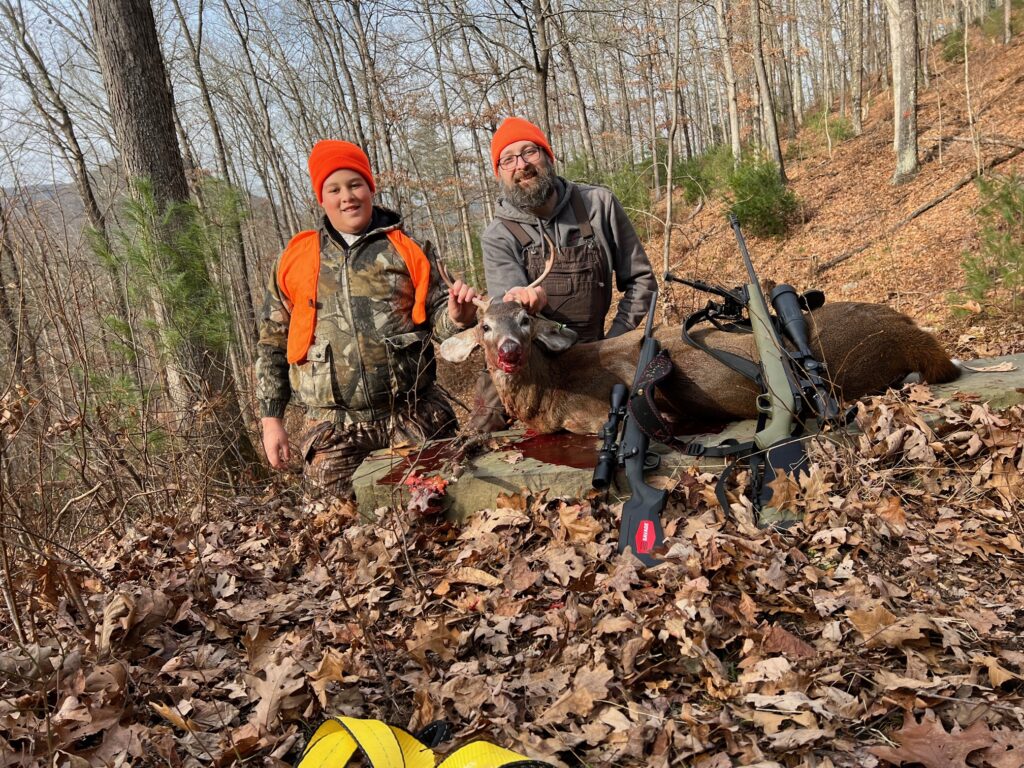
Phil Benner and his son Nate with a large bodied six point buck taken in Pine Creek Valley in late November, 2023
PA’s 2023 bear season
After hearing just one rifle shot all day (followed by the customary follow-up shot thirty seconds later, and the coup-de-grace shot a minute later) today, at 4:20PM, I felt compelled to write about what seems to be happening this bear season. In a nutshell, this is not your pap’s or even your dad’s Pennsylvania bear season in Northcentral PA. That long-hallowed experience of buffalo plaid Woolrich coats and moldy little hunting camps built in 1948 filled with men putting on big drives across the landscape, is now a thing of the past.
Some people blame the Saturday bear season opener that started eight years ago for the demise. Others blame the early October muzzleloader and archery seasons. Either way, what many hunters are calling the death of the famed PA bear season is actually a direct result of the incredible success of PA’s decades-long bear population conservation program.
When PGC biologist Gary Alt became the steward of the PA bear program in the early 1980s, he faced a problem. Hunters, nature lovers, and simple habitat and ecosystem health required more bears across Pennsylvania. And bears were not responding to the demand. In twenty years of hard and smart work, Dr. Alt turned the situation completely around. When Dr. Alt left the PGC twenty years ago, his life’s work was one of the great wildlife conservation success stories in America. Black bears then filled habitat niches in almost every county from Philadelphia to Erie, from Honesdale to Pittsburgh, and everywhere in between.
And then, almost overnight it seemed, PA had way too many bears. Bears were showing up in cities proper, turning over trash cans in suburban back yards everywhere. And so the PGC had to try and dial back some of Dr. Alt’s success. Increasing the number of bears taken by hunters was the solution.
Now looking at harvest data resulting from a half dozen years of early muzzleloader bear season, early archery season, regular bear season, and extended bear seasons running concurrent with deer season, it is easy to see why we only heard one rifle shot all day today in what probably still is the epicenter of PA’s bear hunting. And why none of our guys encountered any bears hanging from hunting camp porches on their valley run tonight.
Early muzzleloader and archery seasons combined now account for almost half of the overall annual PA bear harvest, even before “bear season” has begun. These early season hunters are mostly single men hunting near their homes. By the time the traditional bear season arrives in late November, half the licensed bear hunters who are likely to kill a bear are already tagged out, and the rest are looking forward to the concurrent bear-deer seasons in their home hunting territories. Few hunters feel compelled to make the historic annual migration north, and why would they?
Those of us, we hardy few, who do still come to the traditional bear hunting ground up north, are faced with an already depleted bear resource, and many fewer men pushing across the landscape to break free and push those bears that remain. And yet, despite our reduced opportunity, we enjoy the crisp Fall air, the camaraderie, the laughs, and the naughty food and drink our wives would never approve of, if they only knew.
Good luck this season, boys. You’re gonna need it.
Turkeys and the critters who eat them
Wild turkeys are one of Pennsylvania’s great conservation success stories. When I was a kid, wild turkeys were like a fable, a mythical animal inhabiting far distant wild lands, that could be seen and maybe heard if you were one of the lucky few. They had been decimated by market hunting in the 1800s and early 1900s. When I took my hunter safety education course at the age of ten at the old Army Reserve building out in the farmland on the east side of State College, the Pennsylvania Game Commission staff proudly showed us films of their successful trap-and-transfer program, where wild turkeys were lured with bait into the range of nets, caught, and then driven to the far reaches of Pennsylvania’s rural areas. Usually State Game Lands with fields.
From the 1970s until the early 2000s, Pennsylvania’s wild turkey population grew and grew, until they seemed to be everywhere, including well south of I-81, the old imaginary dividing line between concrete civilization and wild man country. Apparently turkeys are adaptable to concrete wilderness, because they took up urban residence all over the east coast. Not content with being colorful freeloaders along with the ubiquitous and nasty pigeons and rats in these urban areas from Massachusetts to New Jersey, wild turkeys also provide much hilarity as they attack everything that moves in a display of misguided dominance, including mailmen, soccer moms and their kids, and dogs being walked. Look up the “incident reports” of wild turkey muggings of disbelieving urbanites; lots of funny videos to go along with them, too.
So when turkey populations began to decline in Pennsylvania and parts of New York starting ten years ago, people knew it was not due to the birds’ lack of tenacity. Something new and powerful in the old bird + habitat equation was having an effect.
And in fact in many places here in PA, formerly huge turkey populations are now really low or non-existent. I myself used to look out my windows and watch three separate flocks cycle through our clover-planted yards. When I hunted spring turkeys there (northcentral PA), I would start the day surrounded by gobbling toms, and usually had a couple different opportunities to harvest one within the first few days of the hunting season. It was exciting and fun and a great way to begin the work day, although I will say that by the end of May, I was a hollow shell of a human, having run myself ragged either chasing toms myself, or calling for friends who had not yet filled a tag.
Bottom line is, those old flocks of twenty to thirty birds no longer exist. We are fortunate to see one or two wild turkeys at all on our place. And we have excellent habitat with grouse.
What caused the loss of wild turkeys in PA has generated a discussion similar to the one surrounding the demise of the once amazing world famous smallmouth bass fishery in the lower Susquehanna River. It seems that almost everyone involved has a reasonable opinion about it, and the official experts are being second-guessed by people who have witnessed circumstances different than those described by said experts. The ubiquitous use of trail cameras since 2000 has accompanied this growth in sportsman observational opinion, and very often individual hunters will use their cameras’ footage to make very compelling arguments that contradict official wildlife managers’ narratives.
Something similar happens in the aquatic environment, when thousands of fishermen experience and see something different than what they are being told through official government channels.
So now PGC is toying with the idea of releasing martens into the wilds of Pennsylvania. Similar to the fisher that was released back in the 1990s, martens are a furry little weasel-type animal that, like all weasel type animals everywhere, has an insatiable appetite for everything they can catch and kill. Not necessarily kill and eat. All members of the weasel family (wolverines, fishers, martens, mink, otters, weasels) have periods where they become “surplus killers.” That is, they will kill many more animals than they can eat, just because they seem to enjoy the hunt and the kill. Question being now, What will the new marten do to our turkeys?
Will martens do more of what fishers have so clearly done to PA turkey populations, which is to climb up into trees and eat them while they are roosted and asleep? Will martens only eat turkey eggs? Who knows? And so it follows, why release martens into our forests and farms if we don’t know what impacts they will have?
The question I have, and which I know so many other sportsmen have, is: What kind of studies have been done to date that provide confidence that reintroducing marten will have a net-benefit result, and not a net-negative/cost result?
Most of us agree with government biologists that biodiversity in general is important, and we agree that increasing biodiversity is a worthy goal. But, what are the costs and benefits of doing so? What costs and benefits do marten bring to our forests? I can imagine quite a few costs, mostly impacts on ground nesting birds (like wild turkeys, grouse, pheasant, woodcock, and a zillion species of cute little migratory dickie birds) that are already under tremendous pressure from overpopulating (thanks to urban sprawl) raccoons, skunks, possums, feral cats etc., and I wonder if the benefit of a few hundred citizens annually catching a view of one of these cute and elusive furry weasel-like animals is worth the inevitable costs.
One of the things we must struggle with today is that, as much as we would like to return to the pristine conditions of three hundred or four hundred years ago, where humans had a measurable but relatively minor impact on the environment, the reality on the ground today is totally different. The social carrying capacity among different human groups is one consideration. The carrying capacity of other wildlife is another consideration. I imagine that before people go petitioning or pushing to have these newest predators released back into our forests, we should know what their likely impacts are going to be first. I am willing to sign a petition to have PGC thoroughly study this subject, but I would feel irresponsible to ask the agency to jump before knowing what lies ahead and below.
I will say that I like knowing fishers are in our forests, but I do not like the tremendous impacts they have had on squirrels, rabbits, and turkeys. Everywhere a fisher takes up residence, the small game and turkey populations drop dramatically. Personally, I would prefer to know that there were a few hundred fishers living across Pennsylvania, instead of the thousands we now have that are over-impacting a lot of other equally valuable wildlife (and I enjoy recreationally trapping for fisher every year).
I am not saying that adding martens to Pennsylvania will necessarily be pouring fuel on the fire burning up wild turkey populations, but we really should know. That is the responsible thing to do.
The beautiful power of a free market guitar
A lot of the recent discussion and reporting about the World Economic Forum in Davos, Switzerland, is how hard the participants there are trying to centralize decision making, to aggregate power into as few hands as possible, and to control the choices that individual people have available to them all around the world. This effort to concentrate power and decision making in the hands of elites runs opposite and directly against the democratic forms of government that many people around the globe have fought and died to achieve.
Places like India, France, Britain, Israel, South Korea, Sweden, Norway, Germany, Austria, Italy, Hungary, the Philippines, and of course my home country of America, have all offered their citizens a maximum amount of personal freedom and opportunity. People living there can make all kinds of choices about what they want to read, to say, to wear, to eat, what kind of job they want to try, what kinds of products they want to try and create and sell. And that last part, the creating and selling part, is really at the heart of democracy. Because free markets offer choices not just in economic spheres, but which naturally blend into our own personal lives.
When a person, you the reader here, for instance, feels personally fulfilled by fully following your natural talent and curiosity, and by fulfilling your creative spirit, often also followed by greatly improving your physical living conditions, then you become a maximally happy person. This pursuit of happiness is one of the main reasons that America exists, and it is enshrined in our Declaration of Independence. A nation filled with happy people is a miracle, because it is so rare in human history. So we see that free markets create the most happy, most fulfilled individuals, who are creative, educated, and opinionated.
And we also see with the WEF that the wealthiest people on Planet Earth are now scheming and trying to take that happiness away. The WEF people do not want “little people” individuals to make their own decisions. Instead, they want centralized decision making for all of us, by a very small number of ultra wealthy people. They do not support democracy or free choice or you having an opinion that threatens their power.
I want to share a neat related video with you. To me it is powerful because it touches on this subject of an individual who follows his dream to make the best guitars possible within the free markets that the world allows. He succeeds within the international guitar market, but because of a natural resource constraint – the almost complete loss of ebony trees, necessary for making guitar necks and frets – he takes a big risk, makes some big sacrifices, and ends up playing an even bigger and more positive role in the world.
Bob Taylor, of Taylor Guitars, uses careful market-driven management of rare ebony trees and their surrounding forests to create the conditions necessary for conserving the vast African rainforest jungle those trees grow in. When the local people no longer need to poach ebony trees to sell on the black market, they become protectors of the ebony trees. Economics and free markets keep ebony trees alive, and growing for the future, as well as the richly diverse jungle habitat in which ebony trees grow. This is powerful stuff only achievable by free markets.
The same dynamic is also at play with trophy hunting in Africa, where wealthy hunters pay much more to kill wild game than that same animal is worth as bush meat to the local populations. Because the locals get the meat from the trophy animal (99% of the trophy animal is immediately donated to locals, the hunter and the safari camp getting the other 1%) anyhow, and they also get the hunting and tourism-related jobs from the international visitors who want to see and hunt wildlife, the incentive shifts away from poaching and market hunting to the locals then protecting and conserving the wild game they once saw only as a meal. Again, powerful natural resource conservation as a direct result of free markets.
Long live free markets, personal choice, personal accountability, and personal reward for hard work and risk taking. May the World Economic Forum fail in its effort to end our choices and to make us “own nothing.”
Here is the Taylor Guitar video. I hope it speaks to you like it speaks to me.
(and here is the ten years later video, which is about ebony tree planting and husbandry)
U.S. Sportsmen must vote gun rights next week
[A version of this essay was published by the American Thinker at https://www.americanthinker.com/blog/2020/10/american_sportsmen_must_vote_gun_rights_next_week.html ]
It is not news to anyone who cares about American liberty that guns of every sort, caliber, style, color, and design have been in the crosshairs of anti-gun activists for decades. It is no stretch to describe these anti-gun activists as totalitarians-in-waiting, because their ultimate goal is complete civilian disarmament, which results in only one thing: Tyranny. Yes, even black powder muzzleloading rifles are targeted by gun grabbers, even though the last time an American was hurt by one was when someone took one off the mantel and dropped it on their toe.
Anti-gun activists are especially seeking “universal background checks,” because that process would allow them to build up the kind of individual firearm owner database they need now to do the door-to-door gun confiscation they dream of later on. But on this subject they keep running up against a political and legal buzz saw from the National Rifle Association, Gun Owners of America, Firearms Owners Against Crime, and various state rifle and pistol associations. And so now gun grabbers are going after the one chink in the gun owners’ armor, what they see as the weakest link in the gun owners chain, and that is America’s sportsmen.
Sportsmen are an unusual demographic group of mostly political moderates, super-voters who cherish clean waterways, support land trusts and coastal conservation organizations, and who also cling strongly to their often basic hunting guns. Sportsmen are mostly not the AR15 “black rifle” tactical crowd, and that has made them especially interesting to the gun grabbers.
And so an effort is afoot to convince American hunters, trappers, and recreational fishermen that the most important issues they must vote for and about next week are the environment and public lands. And we all know how that mantra goes: Republicans are bad, and Democrats are good, which translates into Trump Bad, Biden Good. Never mind that most environmental groups are partisan Democrat Party activism centers who use the environment as their excuse to make war, now there are fake sportsmen’s groups and fake gun owner’s groups.
When you dig just a bit under the thin veneer of these groups’ “we are wholesome sportsmen and gun owners just like you” message, what you find is no surprise. They are each just yet one more phony, politically partisan, anti-gun concoction that camouflages itself as something else. Several anti-gun groups in particular are targeting sportsmen with deceptive behavior. The Union Sportsmen’s Alliance and Gun Owners for Safety are chock full of people professing to be ardent gun owners, but who nonetheless inevitably cite the same garbage anti-gun “studies” and who inevitably promote draconian anti-gun policies as “fair,” and “common sense” etc. These fake groups are as easy to spot as phonies as is a pheasant breaking thirty yards out against a clear blue Fall sky.
But a third group that is really gaining traction among sportsmen is Backcountry Hunters and Anglers, and they much more carefully, perhaps artfully, straddle the natural mix of environmental quality and gun ownership interests that sportsmen have. And BHA is strident this year about voting on environmental issues alone, to the exclusion of gun rights. Its president, a guy actually named Land Tawney, has a long association with Barack Obama and Democrat Party activism. BHA is partnering with Patagonia clothing company, which has underwritten and promoted a movie called Public Trust: The Fight for America’s Public Lands. This movie is the centerpiece of BHA’s get-out-the-vote efforts this year.
Public Trust is done in a documentary style, narrated by Hal Herring, a long-time writer for Field & Stream magazine. The movie is masterful and has great cinematography. But it is not always accurate, especially in claims about so-called climate change and hanging every environmental problem and cause around the neck of – you guessed it – Republicans and the Donald Trump Administration. Public Trust also plays the usual environmentalist game of presenting false choices. For example, water quality concerns about the proposed Twin Metals copper mine in Minnesota could be addressed through posting a sufficient cleanup bond, but that would negate all the opportunities for political drama that liberals want.
If President Trump’s political opponents forget to mention that he signed the Great American Outdoors Act just a few months ago, allow me to remind them. The GAOA funded the Land and Water Conservation Fund for the first time since human-caused “climate change” was just a twinkle in Al Gore’s eye. GAOA funded national and local parks and forests operations and maintenance backlogs, infrastructure needs, and a host of other conservation and public lands needs from sea to shining sea. Trump is not an evil anti-environment boogey man, but Joe Biden certainly is an ardent gun-grabber, and his inner circle is a constellation of anti-trapping and anti-hunting groups.
Next week, American sportsmen cannot afford the luxury of voting for anything but Second Amendment rights. Without our guns, there is no sporting tradition, period, so vote for President Donald J. Trump. See you in the field afterwards!

Patagonia clothing company has this confusing message posted on its website. See, to me, a “climate denier” is a “science believer” and a human-caused climate change proponent is at best a gullible fool hyped up on a political cause that has no science in it, behind it, around it.

Who knows where Patagonia got this smokestack city photo, but if it is in America, the white emissions are probably steam. Which is water. Which is not a pollutant. To try to sell this as a picture of commonplace industrial pollution, Patagonia and BHA want viewers to believe we are really living in 1968.
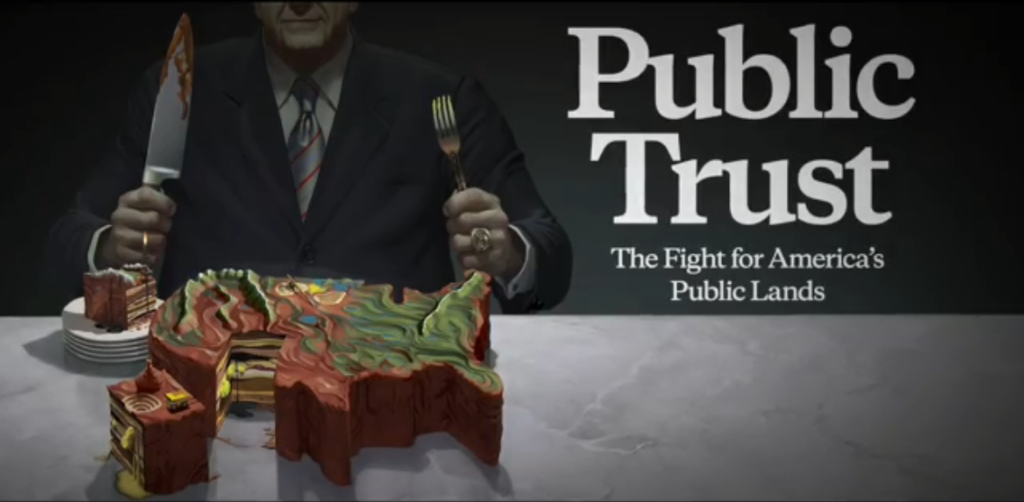
A greedy white man in a suit, carving up parts of America for dinner with his cruel, bloody chef knife. A part of my experience tells me there is a grain of truth to this propaganda, because it is true that America’s natural resources have been utilized for three hundred years. Including now by the Crow Indian tribe on tribal lands, thanks to President Donald Trump.
Trump Great American Outdoors Act hits Conservation Home Run
Conservation is where I have spent my entire career, and it is where my heart resides day in and day out. So it is with great happiness that I see President Trump sign into law the Great American Outdoor Act, which will do the nuts and bolts environmental protection America needs, without the regulation that America does not need.
The fact that so many political appointees within the Trump Administration were cheerleaders for the GAOA says a lot about the political tenor there. So many people accuse the Trump Administration of being some kind of radical “right wing” blah blah, and the fact is that the entire administration is loaded with middle-of-the-road professionals, who hold a mix of political, philosophical, and ideological views. In past Republican administrations, there were plenty of appointees who would have blocked GAOA, or held it up. GAOA is a signature achievement for President Donald Trump, and it is a huge win for Americans.
GAOA fully funds the Land and Water Conservation Fund for the first time in a zillion years. It provides adequate funding for federal and state parks infrastructure updates, operations, and maintenance costs. These are the costs that are always deferred in every administration. It is a subject I wrote my master’s thesis on at Vanderbilt University, and it is a subject that has never gone away, until now: Federal recreational infrastructure has been woefully underfunded for decades. Many state parks across America are in even worse shape than that National Parks.
For example, in 2016 my teenage daughter and I hiked half of the Northville Placid Trail, which runs through the Adirondacks. At the end of our ninth day, as we waited out a looming thunderstorm in a rustic but comfortable lean-to deep inside designated wilderness, on a hike in which we had encountered only a few other people, my daughter sat looking at her dead iPhone. Like Gollum looking at The One Ring, only my daughter looked more disgusted and glum than happily mesmerized.
“I have to get out of here. I want to talk to my friends. I want to know what is happening in the world. We need to go,” she said, and picked up her backpack, jumped down onto the grass, then shouldered her backpack.
Oh, I tried to persuade her to spend the night and stay out of that coming downpour. But she would have nothing of it, and she set off by her own teenage self, going somewhere, maybe anywhere, and I was standing there watching her pick her way into the forest.
Hours later we emerged at Moose River Plains, what maps describe as a rustic New York State recreational area tucked away deep in the Adirondack wilderness. What we found was a boarded up main building, boarded up out buildings, no gate, and no official staff. Instead, a bunch of locals who regularly camp there had taken over the official duties of park rangers. Even the land line phone system was not working. It was a very kind local who drove us, each drenched to the bone and with sodden packs, to the closest village, where we could contact our driver and get back to our own vehicle parked at a Baptist church in Northville, so my daughter could get home and talk with a zillion friends simultaneously.
Turned out that Moose River Plains was victim to a New York State budget that prioritized funding illegal aliens, but not state parks.
The Moose River Plains experience was worse than our visit the year before to Saratoga National Battlefield, by far. But seeing Saratoga National Battlefield, where the brave fight for American freedom and independence was won, in such terrible disrepair and threadbare means, was frankly shocking. One expects the National Park Service to do so much better. And when we spoke with a park ranger there, she was clearly hurt, personally, as she explained the money constraints that park faced. NPS just could not get the job done.
All of this is to say that finally, money floweth in the right direction. The need out there for public infrastructure is almost beyond compute. It is about time that America invested in our national parks and forests, state parks and forests, local and county parks, and the myriad other adjunct little recreational areas, like Moose River Plains, so that Americans might enjoy our public outdoors.
And about that public outdoors thing: Public land is a public good. Public land is one of the very few things that government does pretty well. And even when government land managers fail, the outcome is almost always simple neglect; the land always remains, the wildlife habitat remains. Which means the opportunity for recreation, hunting, fishing, hiking, camping etc remains. It is not a real material loss when land managers screw up or there isn’t enough money to operate the park entrance gate house; just missed opportunities, and putting a frowny face on a public symbol.
Congratulations to President Trump for pushing hard for GAOA, for hiring the right kind of land management staff and public lands leaders, and for caring about our public lands at all levels – local, state, and federal. Trump understands Americans, and he knows how much we care about our public lands, our state parks. And he knows how important it is to constantly invest in those places, so that they don’t fall into disreputable disrepair, like Moose River Plains had fallen.
One of the parts of GAOA that is so very appealing to me is the public land acquisition funding. As development never sleeps, what were nice public spots to hunt or hike in suddenly find themselves cut off or surrounded or overrun by development. It is nice that states and local governments will finally be able to buy that ‘Mabel’s Farm’ the community always wanted, and could not afford.
There is going to be a lot of Mabel’s Farms bought with GAOA money in the next few years, a lot of Nature conserved, and a lot of communities and hunting places protected, as a result. Thank you, President Trump, conservationists everywhere appreciate your leadership on this important policy area.
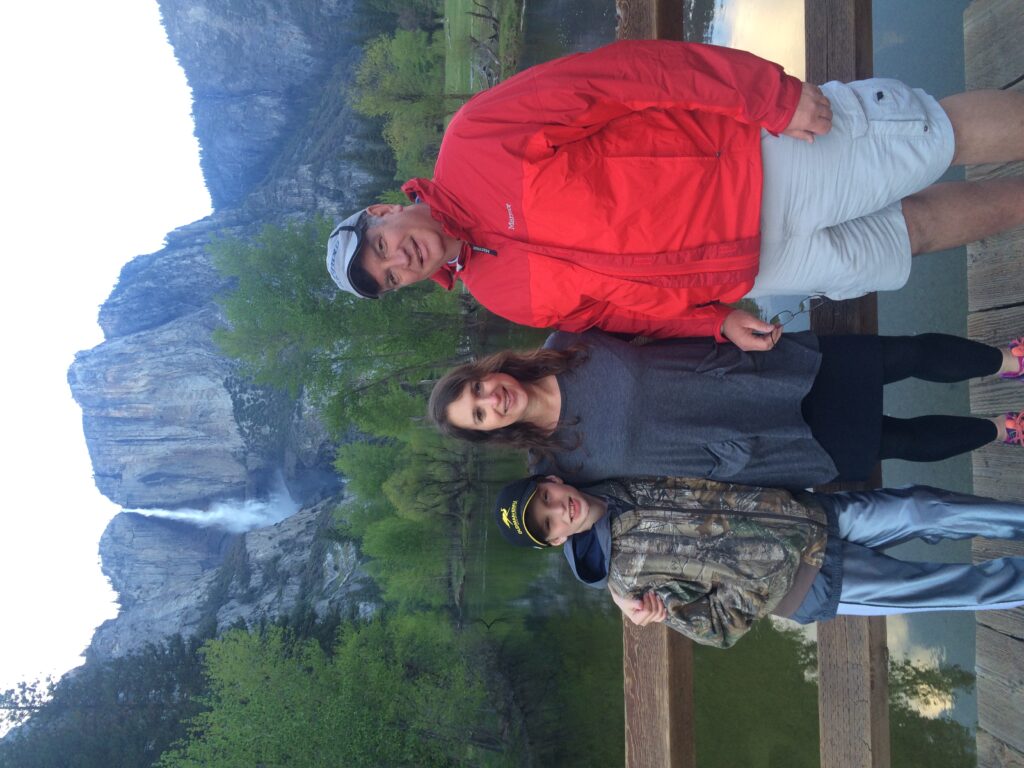
With special people at Yosemite. Can we imagine America without Yosemite? It takes money to protect these special places.

My daughter at the unhappy lean-to. But still, it was a functional, dry lean-to next to clean water in the middle of ADKs wilderness
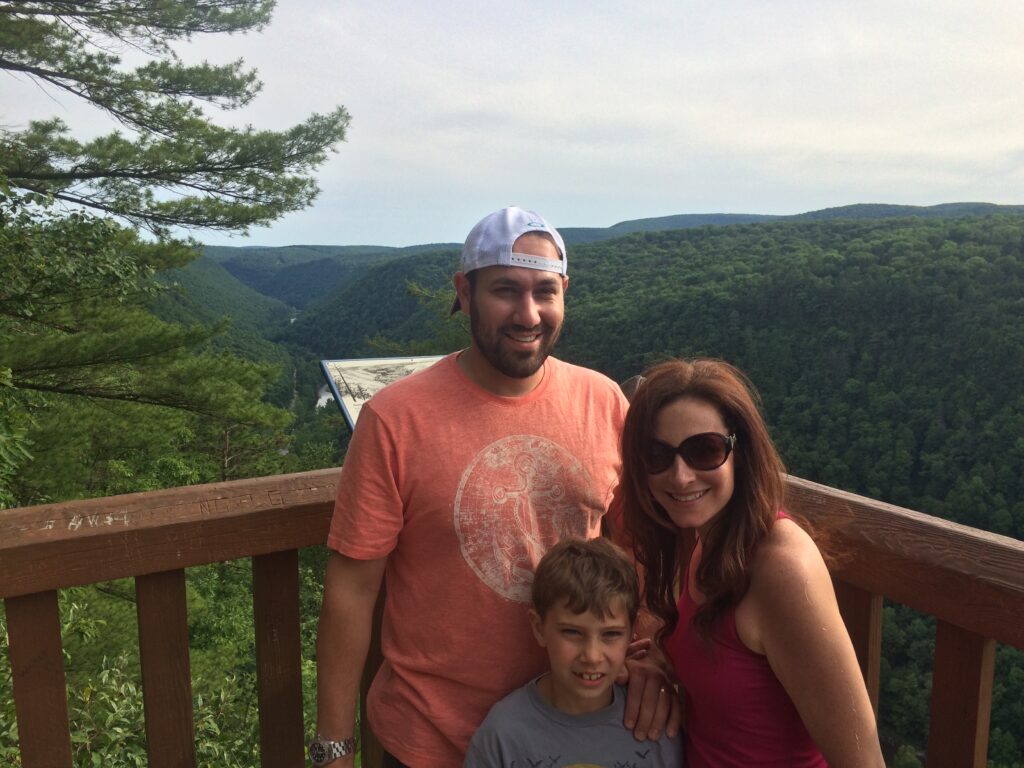
Our friends Mark and Amanda at Leonard Harrison State Park, overlooking the Pennsylvania Grand Canyon
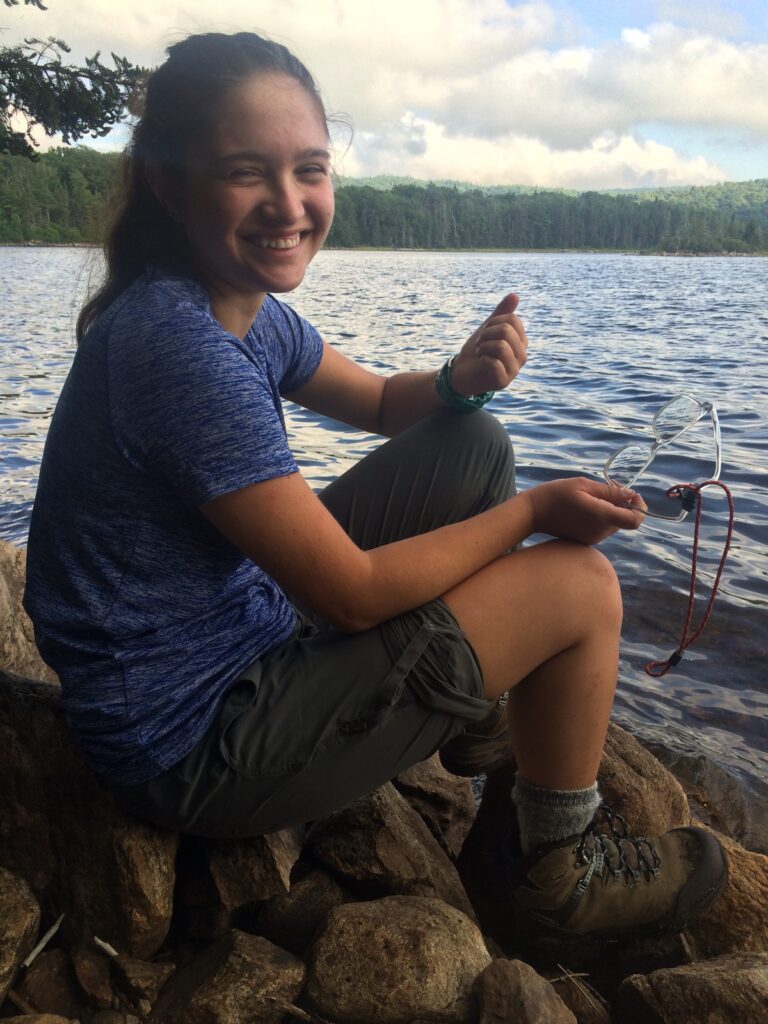
My daughter at Cedar Lakes, a special moment that spurred her on to teach wilderness backpacking to kids. Now she can’t wait to reach the area of no cell reception
Response to PA Gov. Tom Ridge on Conservatives & the Environment
On April 22nd this year, Earth Day, The Atlantic published an opinion piece by former Pennsylvania Governor Tom Ridge, about conservatives and the environment (https://www.theatlantic.com/ideas/archive/2020/04/environment-gop-out-touch/610333/). The Atlantic solicited responses to Ridge’s essay, and so I submitted one to them, but received back no indication they would publish it. They did not publish it, because liberals like those at The Atlantic accept and publish only liberals, and reject conservatives. So here it is, my response to Governor Ridge’s essay about conservatives and the environment.
I felt compelled to respond to Governor Ridge’s essay, in part because I worked in his administration, and in part because I have met few Republicans who can articulate a truly conservative view of environmental policy, which Governor Ridge failed to do. I was also afraid of being seen as attacking someone I hold in high esteem, and I need to say that while I may disagree with Governor Ridge’s essay and some of his recent public stances, like supporting PA governor Tom Wolf’s covid19 lockdown, I remain impressed by Governor Ridge’s high character. I am proud to have served in his distinctively excellent administration.
Governor Ridge’s essay slightly opens a doorway that I am both pleased and also reluctant to push all the way open. But it needs to be opened, all the way, because for far too long establishment Republicans have claimed to be conservatives, while acting like liberals.
Governor Ridge writes his essay “as a conservative,” and despite boldly leading by example in placing highly competent gays, women, and minorities in senior government positions literally decades ago, long before most Democrats followed suit, Governor Ridge was, in fact, a true conservative. His achievements in conservative policy are legion, including Pennsylvania becoming a shall-issue concealed firearm carry state and his administration’s brownfield land recycling program.
Nonetheless, the emphasis today is on he “was.”
Governor Ridge was a conservative, and by today’s standard, he is not. This is not because Governor Ridge has changed, but because what now defines a conservative has changed so dramatically since the time he was governor. The same holds true for liberals, by the way, in their own way (we see the Democrat Party now a totally, openly, violent, racist, anti-America Marxist organization).
And like so many, if not all other political elites, especially Republicans, and most especially establishment Republicans from the hide-bound, bunker-mentality Pennsylvania GOP, Governor Ridge has not changed with the times. Governor Ridge was a conservative, and today he often speaks like a liberal, and sides with liberals on policy disputes. He is not alone in this, but each Republican who does so still causes pain to us conservatives in the political trenches. It is frustrating as hell to experience a former Republican appointee or elected official try to speak with authority as some sort of representative of conservativism, when in fact, they are simply liberals. Or RINOs for short (Republican In Name Only – not conservative).
Probably the biggest indication that Governor Ridge is out of synch with today’s conservatives is how he encourages us to adopt a laundry list of liberal environmental policies in his The Atlantic essay. This means that his solution for conservatives to succeed is for us to adopt liberalism. Even though most of the “environmental” groups are simply employment offices for Democrat Party operatives pushing Marxist, partisan policies. Very few environmental groups today are even seeking solutions, because they are busy dreaming up new problems.
Most of the policies pushed by environmental groups today are by definition Big Coercive Government, Small Defenseless Citizen, anti-Constitution, disregard for private property rights, mountains out of mole hills, and so on. These groups are not about the environment, they simply use the subject of the environment as another avenue to push Marxism and the Big Government necessary to force it down our throats. Governor Ridge should know this, of all people.
What Governor Ridge failed to address is: How can we conservatives embrace the very same failed and inferior liberal policies that drove us to becoming conservatives in the first place? If we adopt liberalism, then we are abandoning conservativism, and failing as conservatives.
Every single environmental policy recommendation that Governor Ridge lists in his essay directly contradicts core conservative principles, like small government, less intrusive government, less spendy government, less activist government, less regulatory government, accountable government and accountable taxpayer-funded government employees. Literally every single policy he lists requires the government to intervene in a big, coercive way, often over trifling differences or demonstrably false premises.
Governor Ridge’s environmental ideas are not conservativism; they are quintessential big government liberalism.
Perhaps the centerpiece of his essay is that conservatives must concede at least a bit on “climate change.” Yet, for conservatives, this particular issue, more than any other, highlights the distinction between us and liberals. For conservatives to agree with the Marxist, disproven, and notoriously phony climate change religion would be to abandon basic, solid, conservative principles altogether….like Capitalism 101, solid math and science, and transparency. Again, we are unpersuaded the climate warming-cooling-change-whatever issue even exists, let alone that a government solution consistent with America’s Constitution could be found.
Governor Ridge writes “The Republican Party has largely abandoned environmental issues.” To which I and a host of other conservatives would respond, No, but many Republicans have abandoned the citizen voters and the forgotten taxpayers of America. Many careerist Republicans have embraced popular culture and its feel-good-now bubblegum policies. For Republicans to respect openly partisan “environmental” groups and embrace liberal nonsense like so-called ‘climate change’ and similar policies would only be one more betrayal in a long line of policy and political betrayals committed by the Republican establishment. Conservatives have perfectly sound environmental policies based on perfectly sound, all-American principles. If you but ask us, we will explain them. We conservatives didn’t abandon environmental issues, nor did we leave the Republican Party. The Republican establishment abandoned us.
Josh First is president of Appalachian Land & Conservation Services, LLC. He has worked at the US EPA in Washington, DC, The Conservation Fund, the Central Pennsylvania Conservancy, and was Director of Environmental Education and Information at the Pennsylvania Department of Conservation & Natural Resources in the Governor Tom Ridge administration.
It’s that time of year again
Plenty of things have gone to hell in a hand basket over the course of the last four or five decades, and I would only be living up my highest and bestest reputation as a grouchy curmudgeon if I ticked them all off here as a laundry list of petty grievances. But other writers and commenters have already done all that, much better than I can, so I am going to mention just one frustration. And it must be credited to that mild mannered conservationist Aldo Leopold, who first put his finger on this, on the very beginning of what ails us Americans today.
If I read one more time the overused phrase “In a Sand County Almanac, Aldo Leopold writes…” I am going to scream. You are there and I am here on the other side of the screen, and we cannot actually hear one another, so it will sound like a silent scream, but rest assured, it drives me nuts and right now I am doing my best silent scream imitation about this. Sure, it is a testament to how inspiring Leopold was and still is that so (so) many people begin all kinds of talks and writings and poems with this opener, citing some comment or observation Leopold made back in the crusty 1940s Dark Ages that yet, surprisingly, has so much application and salience today, eighty years later. But it is so very much overused to the point where it is almost maudlin to hear it used yet one more time.
And then, when I think of those intervening eighty years, well, they have been both a blessing and a curse, haven’t they, and so I find myself in that recognizably similar frame of mind…
So what the hell.
In Aldo Leopold’s A Sand County Almanac, he talks about cutting down a large oak tree with a crosscut saw, and how much history is gliding by as the saw blade traverses across the tree stem. For every few growth rings that are sawn, Leopold lists various wars and human milestones, scientific achievements as well as natural science moments, as the blade cuts deeper. Just that description alone is a pretty cool writing achievement by Leopold. It is a symbol and image that so many people have trouble forgetting.
But then at the end of the essay, just when the reader thinks “Yeah, I suppose cutting fire wood is more symbolic and meaningful than I thought it was, guess there’s a lotta history in those old oaks at Grandpa’s farm,” Leopold suddenly gets to the whole raison d’être of his history lesson (and I am closely paraphrasing here):
“I knew Americans were eventually doomed to cultural rot and failure when we discovered that heat came from a small switch on the wall, and not from cutting our own firewood every year.”
Here in the middle of his gentle outdoor lullaby, Leopold lamented the ease of life that had arrived with then-modern conveniences and services. He saw them as a two-edged sword, cutting both ways, for and against, because working hard for something, especially for your own ambient heat in the dead of winter, is an important lesson about how all humans are in truth part of the natural cycles around us all the time. Participating in these cycles humbles us, brings us into the actual healthy swing of things around us, helps integrate us with the earth’s natural vibe, tune, and wavelength, each of which we ride every moment of every day, even if we are unaware of it. And thus, it helps us thereby appreciate the natural world that sustains us every day. Even if we are unaware of it.
Leopold was advocating for Americans living newly cushy lives devoid of physical challenges to get the hell off their asses and live in the real world, to take responsibility for their own needs and not outsource everything (like the Romans did at their end). Cut their own firewood, grow a garden, shoot a grouse for dinner or a catch a fish for lunch. The ability to be self-reliant is not only an American trait from our frontier days, it is innately tied to all successful human cultures at all times.
Mind if we switch here to someone on the other side of the spectrum from our mild naturalist and wildlife biologist Aldo Leopold, who nonetheless expresses much the same sentiment?
“I hate luxury. I exercise moderation…it will be easy to forget your vision and purpose once you have fine clothes, fast horses, and beautiful women. [All of which will result in] you being no better than a slave, and you will surely lose everything.” — Genghis Khan (brutal conqueror of the entire known world in his time).
As that completely successful “mad butcher” said it, luxuries make humans soft and weak. Hard work makes us strong and successful. If there is a hallmark of modern America, it is that we are awash in luxuries and conveniences, to the point where the younger generations have no idea how we arrived here at this point, how much sacrifice was required to give them these fancy phones and coffees. Our younger people think that luxuries and easy comforts just fall like manna from Heaven.
So, to be the truest, best American you can be, why not cut some firewood?
Here in central Pennsylvania it is that time of year again, the time of year where if you have not yet stacked the last of your firewood in the woodshed, you damned well better get on with it. Ain’t no time to lose. Any week now Mother Nature can show up with a big old cold surprise, a major dose of early Winter, knock out the electricity to your town, and leave you at the mercy of serious cold temperatures. It’ll be nice if we have all of October to enjoy mild Fall weather, with no need to light the wood stove, but you never know what the future brings. Better to be prepared, right?
Funny how something so insignificant as cutting one’s own firewood can be synonymous with an entire culture’s success or failure.

Wildlife biologist Aldo Leopold smoked tobacco, owned guns, ate what he hunted, planted a garden every year, and cut his own firewood. If you have not read A Sand County Almanac, then get it, because a world of special delight awaits you there, and it will change your life.
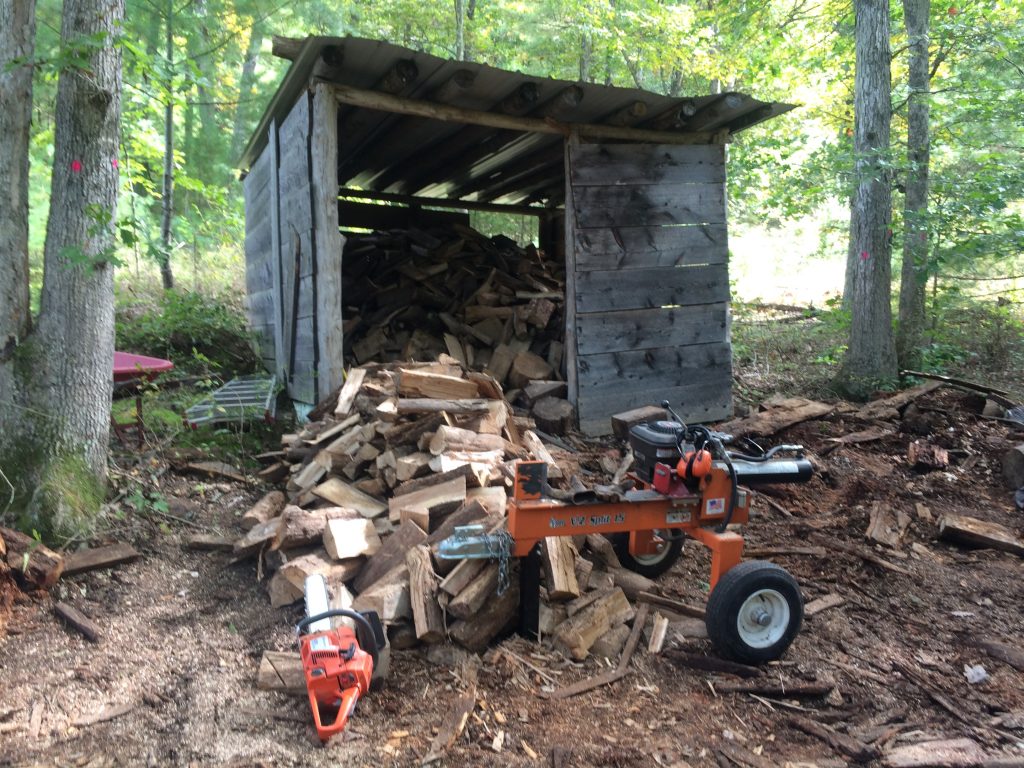
This season’s supply of split firewood stashed in the old woodshed, which is due to be replaced in 2020
Thank you to wildlife’s friends, my friends
When I started writing for Eric Epstein’s Rock the Capitol about eight years ago, one of the first stories I related to readers was an experience two of my children and I had with two pitbulls let off their leashes.
The readership statistics on this one essay were off the charts. Very high volume, and lots of comments. When I asked why, Eric and his website manager, whose name I now forget, told me that news items and stories involving animals claim the biggest share of attention on the Internet.
Fascinating, right?
And we all kind of see this fact in the strange way people routinely show concern for an injured goat in the news by donating a million dollars so the goat can get its broken hoof fixed, and then a truly sad situation involving some news story about a poor unfortunate child whose abusive parents tormented her for years raises just five bucks to get her into a better home.
It is true that people care about animals, and that is a good thing. But this care seems to extend mostly, really overwhelmingly, to domesticated animals; animals that depend upon humans for care and shelter. A natural and healthy empathy is aroused when some unfortunate critter is seen hemmed in by wire or caging, unable to provide for itself and yet not being provided for by the humans around it.
The type of animals people have the least identity with is wildlife. Most Americans, being urban or suburban, simply mythologize wildlife.
From this more urban view, all bears are universally perceived as aggressively dangerous (they are not, though grizzlies are definitely more aggressive than black bears). Deer run out in front of our cars, eat our crops, spread ticks with Lyme Disease, and nibble our yard shrubs, dammit. Squirrels are nasty tree rats with fuzzy tails chewing on our yard furniture, eating the produce of our gardens and fruit trees, and diving our trash bins. And skunks, possums and raccoons are a bunch of rabies-ridden trashcan raiders. And so on.
Wildlife by and large is not greatly appreciated by the general public, unless it is a close-up photo of some baby raccoon or fox kit. And no, I am not talking about wildlife photographers or the insane Humane Society as representative of the general public. These two categories of people are far distant outliers of one sort or another, and no generality can be drawn from their presence among or about wildlife.
So thank God there are sportsmen out there; that is, hunters and trappers. These are the Americans who really do truly care for and about wildlife, and they prove it every damned day with their financial donations and back-breaking work on wildlife habitat projects.
There is no better advocacy group or aggregation of active people who love wild animals and the wild places they need to thrive than hunters and trappers. Time has proven this fact, though the foolish flatlander will claim, with a mouthful of gross stockyard beef in her mouth, that hunting and trapping are “cruel.”
Most of our public lands were first acquired by and for hunting and trapping, at the urging of hunters and trappers. They knew in the 1890s and 1920s that human encroachment into formerly wild areas was leaving no room for the most interesting animals on earth. Many of these animals are more interesting than most of the humans we will encounter in any given day, week, month, or lifetime.
This weekend I really enjoyed my time among a special group of people, the state-wide leadership of the Pennsylvania Federation of Sportsmen and Conservationists (PFSC), what until yesterday was known as the Pennsylvania Federation of Sportsmen’s Clubs (PFSC). Most Americans no longer know that the word “sport” is about hunting, fishing, and trapping, nor do they know what a ‘sporting club’ is about. The lexicon has changed as the daily experience has changed. Meat is no longer acquired from a wild animal who knew it was hunted, but rather from a miserable creature tormented from its earliest days until its last moment alive and turned into a convenient styrofoam package.
The PFSC folks are the people who work every day for the benefit of wildlife, for wildlife habitat, for the defense and promotion of our state parks, state forests, and state game lands. These people do it humbly, quietly, generously, and usually all they get in return is some self-satisfaction from sitting back after a grouse hunt and, despite an empty game bag, intently watching a mysterious red Fall sunset streaked with white wispy trailing clouds sinking down behind shadowy trees shedding their colorful leaves. A deeply comforting stillness overtakes these people at these moments, alone or with companions, and when they go home that night, they know their decades of work fundraising for the latest land acquisition by the Wildlands Conservancy has paid off. It might be a relatively small nook in a big world, but it is a special nook nonetheless, where wildlife — wild animals unknown and unloved by most people — can call home until the next glacier comes through and re-orders the earth’s surface, as has already happened many times in the past.
Here is to you, a heartfelt thank you, my friends, my companions, my betters and my teachers among the outdoorsman fellowship. Thank you for your time and gift to me and to everyone and every living thing around me, whether they know or know not what you do for us.
PA’s Keystone Fund: Symmetrical Program in an Asymmetrical Political World
If there is one rule or overarching principle that taxpayers want applied to how their hard-earned money is spent by government bureaucrats, it is symmetry.
If taxpayers put money in, they expect to get money, or value, back out.
Gasoline taxes? Show me the newly paved highway! Etc. Real simple symmetry.
This is the most elementary social contract between citizens and their self-selected governments, and today ain’t Ninth Century Europe, where armed tax collectors come knocking and begin turning the humble home inside out in search of hidden wealth to take, er…collect.
Today, when the government takes your money by threat of coercive force, you grudgingly turn it over, expecting to at least see some benefit from it.
At budget time is when the legislature and the executive negotiate over how the collected resources of a state or nation are going to be spent. Right now it is budget time in Pennsylvania, and there are no guarantees. Neither the governor nor the legislature has my trust.
Both are up for re-election.
In the middle of it all we have the Keystone Fund, Pennsylvania’s conservation engine. The Keystone Fund is used to run most of Pennsylvania’s “Ranger Rick” – style conservation programs. State parks, state forests, land acquisition, new kiosks, etc. Good stuff. Worthy stuff. The kind of stuff that makes the taxpayer say “Hey, I finally got my money’s worth back!”
The Keystone Fund is funded by taxpayers, but also in large part by the net returns from timber and natural gas sales from public lands. There is an appealing, nearly holy symmetry to any government program that uses money from its own programs to pay for its own programs.
It is the way government should be run!
Now, the Keystone Fund is at risk because it is a symmetrical program living in an asymmetrical political world populated by career politicians who disburse public funds to win public favor, and votes.
Instead of returning the proceeds from timber and gas sales back into the very natural resources that produced them, we now see the likelihood that elected officials will use this income stream to buy off their favorite constituencies. So they can get votes, and get re-elected.
How sad to see one of the very few examples of good public policy, the Keystone Fund, fall victim to something so crass, vulgar and common as an elected official.
To quote Mark Twain: “I think I can say, and say with pride that we have some legislatures that bring higher prices than any in the world.” (Speech 7/4/1873)
